| Bryn Hall | |
|---|---|
 Bryn Hall | |
| Location | Bryn Park, Ashton-in-Makerfield, Metropolitan Borough of Wigan, Greater Manchester |
Bryn Hall, also called Brynne Hall, is situated in Bryn Park, Ashton-in-Makerfield, Greater Manchester.
| Bryn Hall | |
|---|---|
 Bryn Hall | |
| Location | Bryn Park, Ashton-in-Makerfield, Metropolitan Borough of Wigan, Greater Manchester |
Bryn Hall, also called Brynne Hall, is situated in Bryn Park, Ashton-in-Makerfield, Greater Manchester.
The Ashton in Makerfield seat of the Gerard family was Bryn Hall, in their estate Bryn Park, Ashton in Makerfield. Brynne Hall became the seat of the Gerard family by the marriage of William Gerard to the daughter and sole heiress of Peter de Brynne in 1250. The estate is now used for arable purposes, although part of it has been used for the Landgate housing development. It has been suggested that the site of the Old Hall should be excavated to find the remains of the house; however, the landowner has dug it up. [1]
New Bryn Hall was built by a different section of the family. It was erected during the reign of Edward VI and was built around a courtyard and entered by crossing a narrow bridge over a moat that surrounded the property. The hall had a gatehouse secured by huge doors. A porch led to the great hall, which had a railed gallery along one side used to observe entertainments below. The gallery was supported by richly carved double pilasters, which were later removed to Garswood Hall (The original stone footings of this building were no more than 40 feet square, so the 'great' hall wasn't as 'great' as you might imagine).
Thomas Gerard was High Sheriff of Lancashire in 1557. His son, Thomas Gerard, was created Baronet Gerard of Bryn in 1611. The Baronet's brother, Fr. John Gerard, was later ordained a Roman Catholic priest of the Society of Jesus and left behind a detailed memoir of his underground ministry in Elizabethan England
The Roman Catholic priest Fr. Edmund Arrowsmith, who was canonized by Pope Paul VI in 1970 as one of the Forty Martyrs of England and Wales, was related to the Gerards on his mother's side, and after his execution in 1628 his hand was reportedly cut off and preserved at the Hall in a white silk bag; it was referred to as the 'holy hand'. [1] [2] The Gerards were Royalists during the English Civil War. In 1651, Charles II travelled through Wigan and lodged at Bryn Hall on his way from Scotland to his ultimate defeat at the Battle of Worcester. [3] New Bryn Hall had completely collapsed by the end of the 20th century.
In the early 1600s the Gerards left Bryn Hall for nearby Garswood Hall before moving into New Hall, which dates to around 1692 and which they obtained from the Launder family; it has since been renamed Garswood Hall. [2] New Bryn was later demolished.
Later, another 'Bryn Hall' was built, on a different site some distance from the original, by an offshoot of the Gerard family (Richard Gerard in marriage to Margaret Baldwin). The Crippin family moved into this hall and developed coal mining on the estate. In 1870 20 men were killed and 1873 six men were killed in explosions at Bryn Hall Colliery on the Bryn Hall Estate. Bryn Hall was home to colliery owner Edward Frederick Crippin.

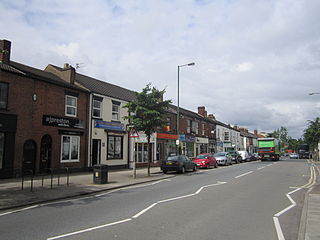
Newton-le-Willows is a market town in the Metropolitan Borough of St Helens, Merseyside, England. The population at the 2011 census was 22,114. Newton-le-Willows is on the eastern edge of St Helens, south of Wigan and north of Warrington.

Ashton-in-Makerfield is a market town in the Metropolitan Borough of Wigan, Greater Manchester, England, 4 miles (6.4 km) south of Wigan. As of the 2021 census, there was a population of 26,380.

There have been three baronies created for the Gerard family who lived historically at Bryn, Ashton-in-Makerfield, Lancashire and Kingsley, Cheshire, in the 13th century. The third and current barony was created in 1876.
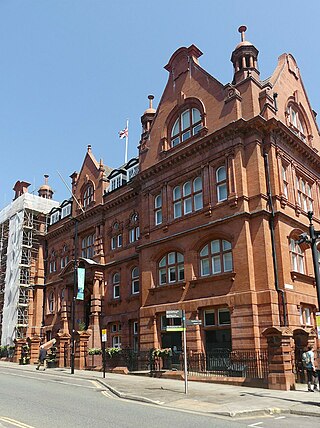
The Metropolitan Borough of Wigan is a metropolitan borough of Greater Manchester, England. It is named after its largest town, Wigan but covers a far larger area which includes the towns of Atherton, Ashton-in-Makerfield, Golborne, Hindley, Ince-in-Makerfield, Leigh and Tyldesley. The borough also covers the villages and suburbs of Abram, Aspull, Astley, Bryn, Hindley Green, Lowton, Mosley Common, Orrell, Pemberton, Shevington, Standish, Winstanley and Worsley Mesnes. The borough is also the second-most populous district in Greater Manchester.

Haydock is a village within the Metropolitan Borough of St Helens, in Merseyside, England. At the 2011 Census, it had a population of 11,416 Haydock's historic area covers the Haydock electoral ward and a section of the Blackbrook ward.

Lancashire is a county of England, in the northwest of the country. The county did not exist in 1086, for the Domesday Book, and was apparently first created in 1182, making it one of the youngest of the traditional counties.

Garswood is a village in the Metropolitan Borough of St. Helens, Merseyside, England. The village is within the civil parish of Seneley Green. The parish was part of Ashton-in-Makerfield until the 1974 boundary changes.

Bryn is a suburb of Ashton-in-Makerfield in the Metropolitan Borough of Wigan in Greater Manchester, England. The population of the suburb at the 2011 census was 11,662. Served by Bryn railway station, Bryn is home to the Three Sisters Recreation Area which has been created from three large spoil tips which remain from Bryn's role in Lancashire's coal mining past.
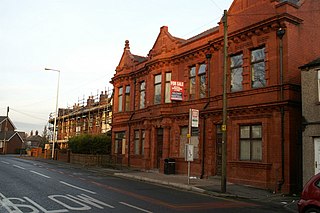
Abram is a village and electoral ward in the Metropolitan Borough of Wigan, Greater Manchester, England. It lies on flat land on the northeast bank of the Leeds and Liverpool Canal, 2 miles (3.2 km) west of Leigh, 3 miles (4.8 km) southeast of Wigan, and 14.5 miles (23 km) west of Manchester. Abram is a dormitory village with a population of 9,855.

Ince-in-Makerfield or Ince is a town in the Metropolitan Borough of Wigan, in Greater Manchester, England. The population of the Ince ward at the 2011 census was 13,486, but a southern part of Ince was also listed under the Abram ward. Adding on this area brings the total in 2011 to 15,664.

Byrchall High School is a secondary school and specialist mathematics and English school with academy status, in the Ashton-in-Makerfield area of the Metropolitan Borough of Wigan, Greater Manchester.

Sir Thomas Joseph de Trafford, 1st Baronet, was a member of a prominent family of English Roman Catholics. He served as commander of the Manchester and Salford Yeomanry at the time of the Peterloo Massacre. He was born at Croston Hall near Chorley, Lancashire, on 22 March 1778, son of John Trafford and Elizabeth Tempest, and was christened Thomas Joseph Trafford.
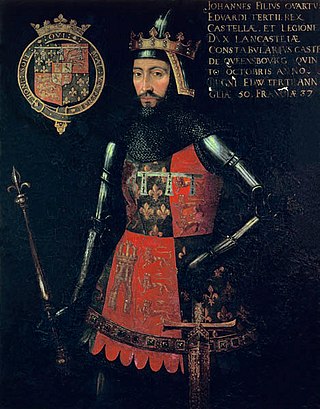
The High Sheriff of Lancashire is an ancient officer, now largely ceremonial, granted to Lancashire, a county in North West England. High Shrievalties are the oldest secular titles under the Crown, in England and Wales. The High Sheriff of Lancashire is the representative of the monarch in the county, and is the "Keeper of The King's Peace" in the county, executing judgements of the High Court through an Under Sheriff.

Sir Gilbert Gerard was a prominent lawyer, politician, and landowner of the Tudor period. He was returned six times as a member of the English parliament for four different constituencies. He was Attorney-General for more than twenty years during the reign of Elizabeth I, as well as vice-chancellor of the Duchy of Lancaster, and later served as Master of the Rolls. He acquired large estates, mainly in Lancashire and Staffordshire.
Edward Frederick Crippin was an English businessman.
Bryn Hall Colliery was a coal mine on the Lancashire Coalfield in Bryn, Ashton-in-Makerfield, Greater Manchester then in the historic county of Lancashire, England. The colliery was first worked 1859 to 1864 by Smith & Sons before ownerships transferred in 1866 by Crippin and Smethurst who left the partnership a year later. It was owned by Crippin and Sons in 1868, W and B J Crippen in 1871 and in 1873 William Crippin, the owner was sinking new pits. The owners between 1875 and 1886 were W and E F Crippen followed by E F Crippen and H H Crippen up to 1892.
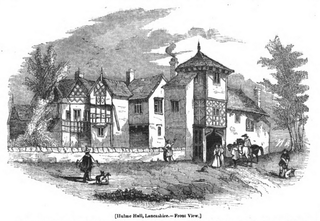
Hulme Hall was a manor house adjacent to the River Irwell in Hulme, Manchester, England. A structure of this name existed from at least the time of Henry II (1133–1189) until its demolition around 1840 during development related to the Bridgewater Canal. Owners included the Prestwich and the Mosley baronets prior to the property being bought from George Lloyd in 1764 by Francis Egerton, 3rd Duke of Bridgewater.

The Hulton family of Hulton lived and owned land in Lancashire for more than eight hundred years from the late-12th to the late-20th centuries. The family took its name from the three townships surrounding their Hulton Park Estate, Over, Middle and Little Hulton.
Notes
Bibliography